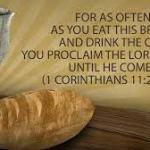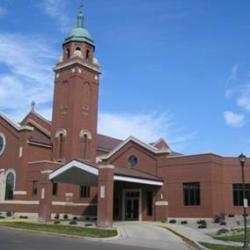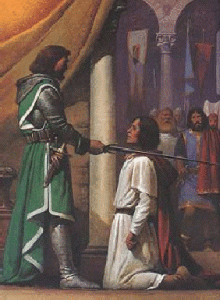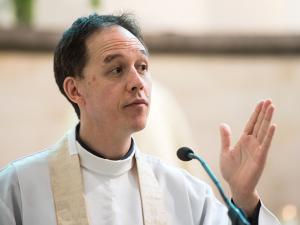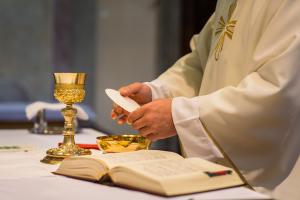
Communion is the most important part of the Mass. I believe that now, but I didn’t always. In the past I would have given that place to the Consecration. Well, the Consecration is a pretty big deal. What was mere bread and wine becomes, substantially, the body, blood, soul, and divinity of Jesus Christ. A miracle, if you want to call it that, though not the sort that gets around any laws of nature.
This change is completely lost on the space visitor we’ve been following around in this series. It’s equally opaque to the senses of the most fervent Christian. But our senses and the alien visitor have a point. By itself the transubstantiation doesn’t make the difference that liturgy intends. It doesn’t accomplish the work of the liturgy.
This is the sixth in a series on the Mass. I’ve been letting the various actions and experiences of the Mass speak their meaning to an interested, theologically untutored, and so quite observant space alien. Though there are some things this imaginary figure can’t see, I’m finding what she does see quite instructive.
The first Communion
Think back to the Last Supper, when Jesus gave us the words of consecration.
This is my body, which will be given for you.
This is the cup of the new covenant in my blood [or something like that]. It will be poured out for you and for many [i.e., the non-Jewish nations] for the forgiveness of sins.
Was Jesus thinking more about his presence in the forms of bread and wine or with what he was about to do and endure the next day? That meal was important. Jesus meant his followers to continue enacting it as a memorial – “Do this in memory of me.” But what were they to remember? Not just this last sacred meal but the giving and the pouring out that would happen on the cross. In the same way the Consecration at Mass needs the “given for you” and “poured out for you” that happens at Communion.
All honor and glory and everything else
Our space visitor and our senses can tell some difficult work is happening with this great offering:
Through him and with him and in him, O God almighty Father, in the unity of the Holy Spirit, all glory and honor is yours, forever and ever. Amen.
Here the sacrifice of praise that the Eucharistic Prayer is comes to its climax. We get specific about what we are giving up, and, if we’re paying attention, we know how hard it is. We sacrifice that claim of our ego that something, however small, is all mine. It may be this space or this role that I take on in my relationships. This ego craves credit for something and maybe even blame. But it’s my own, my way of separating myself from you. It’s what I imagine I need to be me.
We have built walls separating ourselves into private individuals and competing groups. We see the resulting conflict, bitterness, and pain; but it seems impossible to relinquish these walls. Then we come to liturgy and in one sentence we say we give it all up. “All glory and honor” are God’s. We profess that we no longer need or want that image we claimed and struggled to maintain to the detriment of everyone else’s and even our own happiness. Jesus makes it possible to say this and mean it. “Through him, with him, and in him, in the unity of the Holy Spirit,” we make our prayer. Jesus already offered to God perfect praise once and for all. We can honestly say, “We offer,” because Jesus’ sacrifice embraces our imperfect struggles.
It’s a sacrifice, but it turns out to be a blessing. On the other side of this sacrifice, we find ourselves as diverse as ever but now with sisters and brothers and no walls between, in a new, blessed, and a vastly more interesting place, before God, where unity is not uniformity and our differences call forth a response of love. We dare to empty ourselves, and we find that we are filled.
More than words, battering down walls
In the Communion Rite we live the meaning of what together we have just said. This is one steady progression of knocking down everything that would make walls, and has been making walls.
The Communion Rite is actually a long reconciliation rite that reaches its climax in the sharing of bread and cup. It includes:
- the Lord’s Prayer,
- the Sign of Peace,
- the Breaking of the Bread and the Lamb of God,
- the “Lord, I am not worthy,“
- the Communion Procession,
- and a final prayer.
Our space visitor rightly sees this whole Communion Rite as the most exciting part of the Mass.
Our daily bread is enough
The Lord’s Prayer starts the movement toward Communion. It first echoes the praise of the Eucharistic Prayer: Father, hallowed be thy name, not ours. We ask for bread, i.e., just those things that we need, not the unsustainable wants pursuing which makes us rivals. And we specify that reconciliation means forgiving and being forgiven.
Peace be with us!
The way the Sign of Peace rite begins takes our space visitor by surprise. The presider prays,
Look not on our sins …
And she’s expecting to hear something like
but do look on the good that we accomplish, on what we are like in our best moments.
What do I expect after “Look not on our sins”? Most of the time, nothing. But when I don’t just let the words flow by, I have to admit that the next words are a shock:
Look not on our sins, but on the faith of your Church.
The opposite of a sin is not a good deed, but faith. We ask God for peace not because we’ve ever done anything to deserve it but because, together as God’s Church, we simply trust God will accomplish it.
Here’s another odd thing our space visitor notices. The priest opens arms wide and says to all the people, “Peace be with you.” We answer politely and then turn to each other and say exactly the same thing. Was once not good enough? My very observant visitor from space has got me thinking. What if I turned to my wife at this time and said, “Peace be with us”?
That would add a new dimension to the blessing the priest just gave. Little conflicts and divisions (sometimes not so little ones) sneak into our relationship. My peace wish is not just a general good feeling that anybody could wish anybody else without any cost. I want us to have the peace that addresses specifically this situation. Our presider doesn’t know all the dividing walls that I cherish. Only I can say, “Let Jesus break down my own particular dividing walls.”
Though many, we are one.
The symbol Breaking of the Bread had great significance in the early Church. In Paul’s words, “Because the loaf of bread is one, we, many though we are, are one body, for we all partake of the one loaf.” (1 Corinthians 10:17)
This rite is a symbol of unity partly obscured by the convenient practice of using small, mass-produced wafers (“hosts”) for the assembly with a larger host for the priest. For all practical purposes, the symbolism was lost completely in the old liturgy. In a little ceremony we couldn’t see, the priest broke the large host in half. Then he ate both pieces himself! On her earlier visit our space visitor thought the priest got the most bread because he was the most important person in the group. That, along with the Communion rail, was just another wall separating higher from lower in the Church.
Now the breaking ceremony occurs in full view of the people. We can see the smaller pieces from that large host as the priest puts them on the plate with the other hosts. Occasionally now, when I approach Communion, I receive a piece from that broken “loaf.” It’s about the same size as what the priest and everybody else gets. I remember that Breaking of the Bread is a title early Christians gave to the entire liturgy.
While the presider breaks the bread, the people sing the Lamb of God. This is a plea for mercy and peace from the one who breaks down walls of the sins of the world.
We echo the centurion’s prayer.
Our “Lord, I am not worthy” ends with the confident “but only say the word and my soul shall be healed.” The translation we now use has “my soul shall be healed” in place of “I shall be healed.” It sounds more like the centurion’s request to Jesus:
Lord, I am not worthy to have you enter under my roof; only say the word and my servant will be healed. (Matthew 8:8)
But it means less! The centurion didn’t ask Jesus to heal the servant’s soul. Neither do we need healing for just our souls but for our whole selves. I like the older translation, “I shall be healed,” better.
Still, either way it’s a beautiful prayer, especially as it echoes the centurion’s admission of unworthiness. Only God is worthy, and we build all sorts of walls by forgetting that.
Sharing in the bread and cup
Going through all these steps, one can imagine Jesus breaking down one after another of the dividing walls that we habitually cling to. It is an act of courage to join in the banquet of unity.
The Communion Procession is one long reverent act. It feels like an altar call, a commitment. It’s a community action; we find support in each other. This is a solemn, serious undertaking. In this long Communion Rite, we enact in symbol the reconciliation that God has provided for us. Here, and not at that prayer “Lord, have mercy” at the beginning of Mass, is where God forgives our sins.
I remember old debates about meal and sacrifice. The Mass is both, but which is more important? Some lined up on one side, some on the other. Others supposed that the two must be about equal. Much better, I think, is to see the Mass as both meal and sacrifice all the way through. At each of the two main parts of the Mass we are nourished and called to give of ourselves at the same time.
We are nourished in the Liturgy of the Word with the encouragement that comes from knowing that we are together in a common story, but there is also a giving up of self here. Our stories are not our own. They are all God’s story. We don’t belong to ourselves. We are God’s.
Jesus nourishes us in the sacred meal of the Eucharist. But this nourishment also means sacrifice. Meals in common usually do include elements of sacrifice. We lose some control over our lives when we join another for a meal even when we’re guests and can reasonably get out of most of the work. We’re accepting something from another and that leads to future obligations.
The people’s dangerous work
I have heard people complain that the priest should wait until all are served before partaking of the meal himself, as if the priest were the host and we the guests. We need to think of God the Father as the honored guest at this meal and ourselves with Jesus as hosts. It’s not just a meal, at least, no ordinary one. It’s also a daring, dangerous leap into communion. For the priest to stand by while everyone else goes first is not the considerate thing to do.
The words that we say when receiving Communion tell us what we are getting into:
The Body of Christ . . . Amen.”
Food certainly, but not just that. Eucharist is a serious undertaking. No abstract, easy commitment, either. The presence of Christ is real, not just an idea and not just a person in an old story. The Body of Christ is a body with members. Those members include people present and far away, especially the very ones with whom we spent so much energy building up walls.
We say AMEN to our union in Christ with all of them. We do this while joining in song, not privately meditating. Joining together for the entire duration of the Communion Rite assures us of who we are—a body in Christ. It tells us what we are just now working at—committing ourselves to each other and to Christ. We are in this together. We rejoice with each one of our sisters and brothers making this same commitment.
Silence and the Prayer after Communion
The Communion Procession over, there is a moment of deliberate silence. Some use this time to thank Jesus for coming in Communion. Others don’t quite know what to do with this silent time. I think the latter approach is more real.
Communion is more than Jesus coming to us. It’s a difficult work that all take part in. I remember being part of a group working hard at a very difficult task. One unexpected detail after another demanded attention. Finally the job was done. We breathed a sigh of relief and stood around doing not much of anything. There didn’t seem to be anything to do for a moment. Wordlessly, perhaps, we honored the work that had been done.
That’s the way I think of the silence after Communion. We honor the work of becoming one body joined to Christ and each other. It is Jesus’ work to which he welcomes us, so we also honor and thank Jesus.
The presider sums up our silent prayers and closes the Communion Rite with the Prayer after Communion.
Think again:
Think back to Masses you have celebrated. In what ways do you see both sacrifice and nourishment there? What does it mean that the words of consecration (“This is my body … This is the cup of my blood….”) are tucked inside a prayer of praise to God the Father? Why does the liturgy put the Sign of Peace before Communion and not at the beginning of Mass? When you go with family or friends to a restaurant, which is better for the waiter say, “Enjoy your meals” or “Enjoy your meal”? How does this apply to Communion?
Image credit: Busted Halo



